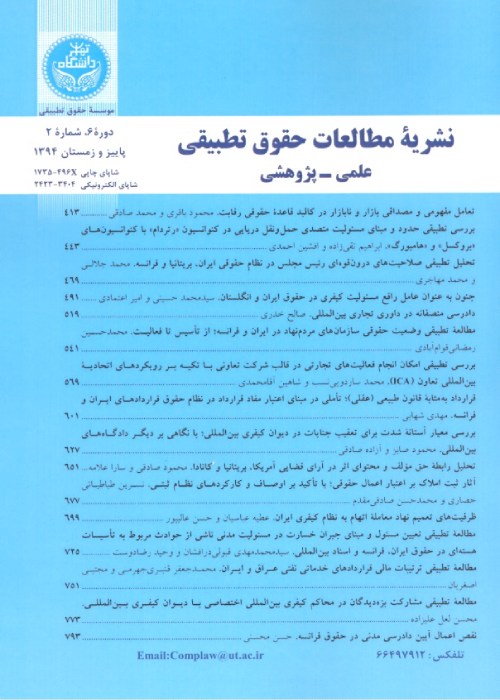A study of the conflict of law rule applicable on Security agreement against a right to payment of a monetary obligation under UNCITRAL Model Law on Secured Transactions: Approaches for reviewing Iranian law
The UNCITRAL Model Law on Secured Transactions which was approved by the UN General Assembly in 2016 has provided for rules on conflict of laws to determine the applicable law on secured transactions. These rules separate the contractual aspects from the property aspects of each secured transaction. The contractual aspect includes the mutual rights and obligations of the grantor and the secured creditor. Contractual aspect involves the mutual rights and obligations which are created between the parties to the agreement. It also includes the effects of the contract against third parties who might be affected by this contract. The effects of a contract on secured transactions will affect three parties. The first party is the guarantor who demands money from another person as collateral. The second party is the guarantor who accepts the mortgaged property. This contract is considered obligatory for the guarantor, but it is regarded voluntary for the other party. The latter whenever wishes might waive the collateral and if the guarantor has incurred costs in enforcing the collateral, the guarantor must reimburse these costs. The third party who owes money although is considered to be a third-party collateral for the contract. However, because his liability is the source of his debt, if he is notified of a security right in a receivable he is obliged to fulfill its obligation upon request. The second paragraph of Article 1 of the Model Law extends the scope of this law to the transfers of receivable contracts. This paragraph states that: “except otherwise is provided in Article 72 to Article 82, this law shall be applied to transferees by agreement of the parties”. Property aspect of a contract on secured transactions involves the creation of effectiveness for third parties and priority of a security right among competing creditors. This distinction has been made on the basis of the protection of certainty principle and predictability objective as well as the protection of reasonable expectations of involved parties and also the protection of third parties’ rights. The model law considers that the law chosen by the parties would be the applicable law on the contractual aspect of security rights. In the absence of a choice of law by the parties to a contract on secured transactions, the law of a State that the security agreement has most closely connected with it will be applied. This place is the place where the characteristic of the agreement as the most important part of the obligations arising from security agreement have the most resemblance with the law of that country. Because the monetary obligation owed to the debtor of the receivable is used as encumbered asset, the UNCITRAL Model Law on Secured Transactions, makes the relationship between secured creditor and the debtor as the subject of applicable law between the debtor and grantor as the principal creditor. This is to protect the debtor’s rights regarding the property aspect of the security agreement, the law on the location of the grantor has been determined as the applicable law, although there are exceptions to this rule. The purpose of the UNCITRAL Model Law on Secured Transactions is to establish a new system for endorsing obligations by means of movable property, both tangible and intangible. This law provides for conflict resolution of laws to determine the law governing the agreement. Protecting certainty and predictability, as well as the legitimate expectations of stakeholders are considered as criteria for determining the rules on conflict resolution. The contractual aspect deals only with the rights and obligations arising from the contract and is limited to the relationship between the guarantor and the pledgee and the debtor of a monetary claim. Regarding the contractual aspect, the law governing the mutual rights and obligations of the guarantor would be their chosen law. In the absence of the selected law, then, a law which has the closest connection with the contract shall be applied. The benchmark for the determination of the closest relationship is to realize which of the parties fulfills the most important and major part of the obligation so that the law of his place of residence can be considered as the governing law. In this vein, the most important part of the contract relates to the nature of a contract, and it is a part of a contract which the contract was mainly created because of it, and if it does not exist, it is not a contract. The selection of the most important part of a contract does not have a precise criterion and is at the discretion of the court and can lead to conflicting results. In the relationship between the guarantor and the debtor of a monetary claim, as the contract cannot restrict the rights of third parties, the same law governs the contract between the debtor and the main creditor, namely, the guarantor. The financial aspects of a contract include the conclusion of a contract and relying on third parties and applying the priority of collateral over various creditors. In these cases, the principle of sovereignty of the guarantor is not governed and the model law in accordance with the type of property has developed a conflict resolution rule. If the mortgaged property is tangible property, the law of the place of occurrence of the property will prevail over these aspects. However, if the property is an intangible property, the law of the place of pledge of the guarantor will govern these aspects to protect the rights of third parties. In the context of the Iranian law, all contracts are governed by Article 968 of the Iranian Civil Code and Article 27 of the International Commercial Arbitration Law of Iran. These two codes do not distinguish between the contractual and property aspects of a security agreement. This study suggests that in the Iranian law, the model law approach should also be implemented to determine the rules of conflict of law so that the applicable law on security agreement can be ascertained.
- حق عضویت دریافتی صرف حمایت از نشریات عضو و نگهداری، تکمیل و توسعه مگیران میشود.
- پرداخت حق اشتراک و دانلود مقالات اجازه بازنشر آن در سایر رسانههای چاپی و دیجیتال را به کاربر نمیدهد.



